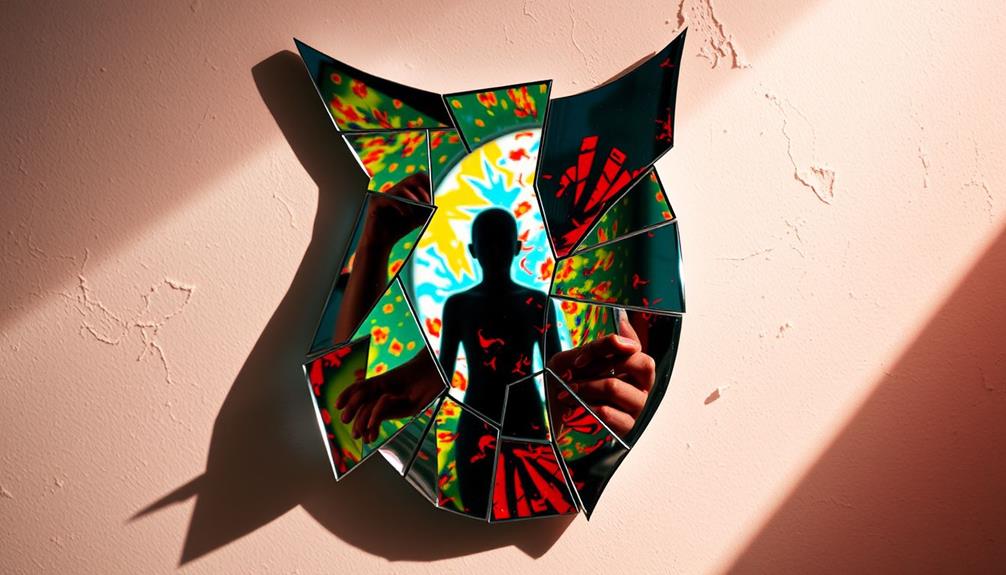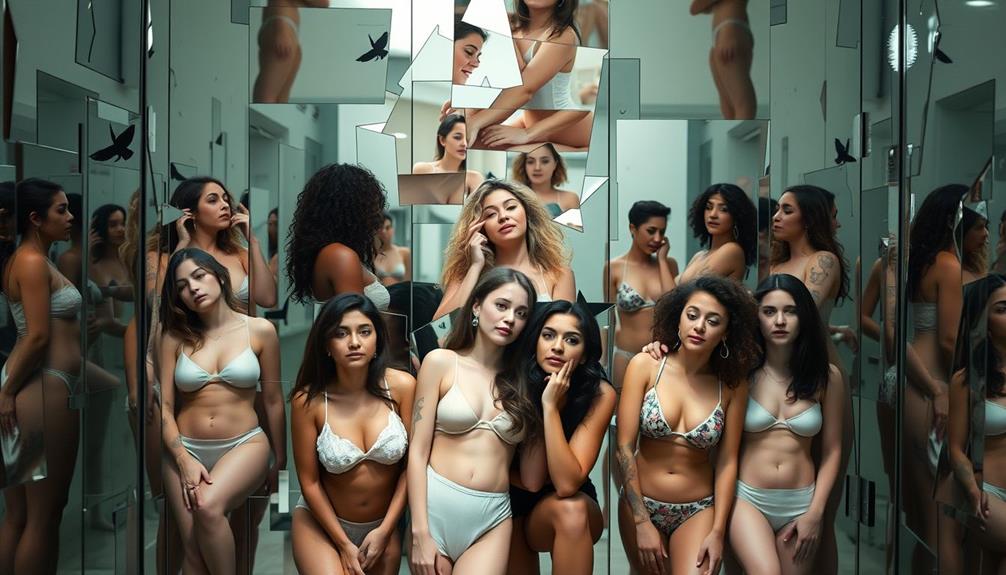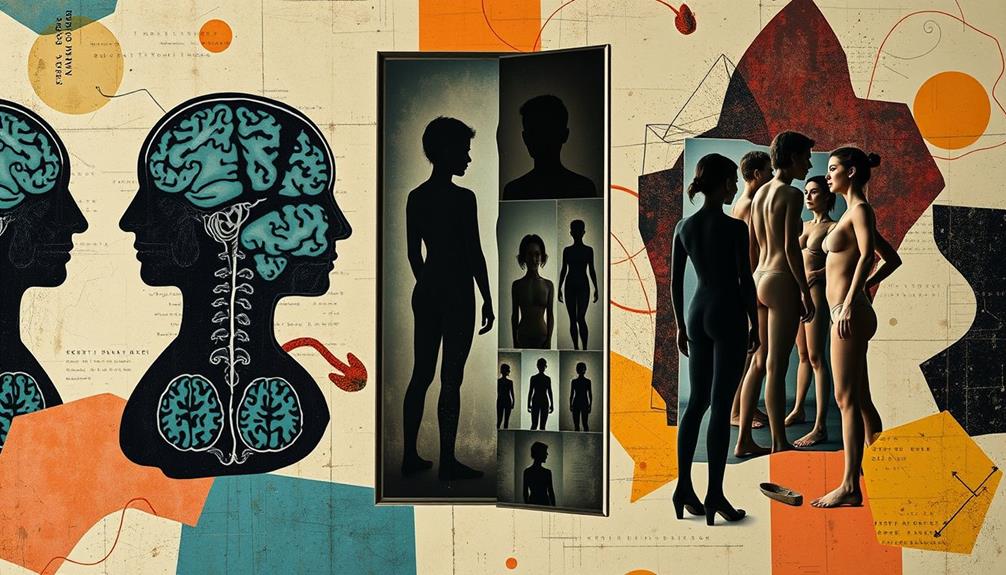If you have Borderline Personality Disorder (BPD), you're likely to struggle with body image issues. Many people with BPD report significant disturbances in their self-perception, which can lead to low self-esteem and emotional turmoil. This often results from emotional dysregulation, making it difficult to maintain a positive view of your body. Factors like societal beauty standards and unhealthy relationships can worsen these feelings. Therapeutic approaches, such as Dialectical Behavior Therapy (DBT) and Cognitive Behavioral Therapy (CBT), can help you build a healthier self-concept. There's more to explore about how BPD affects body image and your overall well-being.
Key Takeaways
- Individuals with BPD often experience significant body image disturbances, leading to negative self-perception and emotional dysregulation.
- Body image issues in BPD are influenced by key components such as perception, self-esteem, and emotional instability.
- There's a strong correlation between severe BPD symptoms and body dissatisfaction, as well as increased risk for eating disorders.
- Therapeutic approaches like DBT and CBT can effectively address body image concerns and improve emotional regulation in BPD patients.
- Societal beauty standards and personal experiences, such as bullying, significantly contribute to body image issues in individuals with BPD.
Understanding BPD and Body Image

Understanding the complex relationship between Borderline Personality Disorder (BPD) and body image is essential, especially since individuals with BPD often face significant body image disturbances. You may notice that these disturbances manifest as negative self-perception and high levels of body dissatisfaction.
Research highlights that emotional dysregulation plays a vital role in shaping how you perceive your body, affecting your feelings and thoughts about it. Additionally, the diagnosis criteria for BPD emphasize emotional instability, which can exacerbate body image issues, making it imperative to address these concerns in treatment.
In BPD, body image issues can be conceptualized through three components: perception, affect, and cognition. This means that how you see yourself, how you feel about that image, and your overall dissatisfaction contribute to your experience.
For many women with BPD, negative body attitudes are especially pronounced, correlating with the severity of BPD symptoms.
To address these challenges, therapeutic approaches like Dialectical Behavior Therapy (DBT) and mindfulness practices can be crucial. These methods can enhance self-acceptance and help you navigate the emotional turmoil stemming from distorted body image perceptions.
Key Components of Body Image

When you think about body image, it's important to recognize its key components: perception, self-esteem, and the disturbances that can arise, especially in individuals with BPD.
Your perception of your body considerably affects how you feel about yourself, and negative self-esteem can lead to a cycle of dissatisfaction.
Factors influencing development, such as biological and social elements, can also impact body image perceptions, as seen in key domains of development.
Understanding these elements can help you address and manage body image issues more effectively.
Body Image Disturbances
Body image disturbances in individuals with Borderline Personality Disorder (BPD) often stem from a complex interplay of perception, affect, and cognition, leading to considerable dissatisfaction with how they see themselves.
These disturbances manifest in various ways, often exacerbated by emotional dysregulation and identity disturbance. Additionally, the emotional turmoil experienced by those with BPD may lead to a desire for relief through various means, including consideration of natural remedies, which can complicate their relationship with body image.
Here are some key aspects of body image disturbances in BPD:
- Heightened body image dissatisfaction: BPD patients report considerably more distress regarding their body image than those without the disorder.
- Distorted body perception: You may find it challenging to see your body accurately, leading to negative self-views.
- Use of the Body Image Avoidance Questionnaire (BIAQ): This tool reveals the extent of body image avoidance behaviors among individuals with BPD.
- Correlation with eating disorders: There's a notable link between severe BPD symptoms and the development of eating disorders.
- Emotional dysregulation: Your fluctuating emotions can intensify negative feelings about your body, further complicating your self-image.
Perception and Self-Esteem
Perception and self-esteem play essential roles in shaping your body image, especially for individuals with Borderline Personality Disorder (BPD). You might find that emotional dysregulation greatly impacts your body image concerns, leading to heightened body dissatisfaction. This emotional turmoil can skew your perception of body attractiveness, causing negative self-evaluations that affect your overall self-esteem.
Additionally, engaging in healthy lifestyle choices, such as incorporating antioxidant-rich foods like celery juice, can improve your overall wellness, which may positively influence your self-image.
Individuals with BPD often experience greater identity disturbance, further complicating their relationship with their bodies. As you struggle with self-consciousness, both privately and publicly, these feelings can create a vicious cycle of poor body image and low self-worth. The pervasive nature of body image disturbances in BPD highlights the importance of addressing these perceptions to enhance self-esteem.
Interestingly, research indicates that cultivating positive body attitudes can lead to lower instances of Non-Suicidal Self-Injury (NSSI). By fostering a healthier perception of your body, you can begin to improve your emotional regulation and self-esteem.
Understanding the link between body image and self-worth is essential for your journey toward healing and self-acceptance, allowing you to break free from the confines of negative evaluations and embrace a more positive self-image.
Research Findings on BPD

Research has uncovered significant insights into how Borderline Personality Disorder (BPD) affects body image. Individuals with BPD often struggle with severe body image issues, which can lead to significant body dissatisfaction.
Here's what recent studies reveal:
- Higher body image disturbance scores are common, with key components of perception, affect, and cognition identified.
- Severe body dissatisfaction correlates strongly with the severity of BPD symptoms.
- Elevated self-consciousness—both private and public—can hinder emotional regulation and how you regard your body.
- Increased rates of Non-Suicidal Self-Injury (NSSI) have been linked to body dissatisfaction, with emotional dysregulation acting as a significant moderator.
- Comorbidity with body dysmorphic disorder is prevalent, with more than half of BPD patients experiencing negative body image perceptions.
These findings highlight the intricate relationship between BPD, emotional dysregulation, and body image issues.
Understanding these connections is vital for promoting better mental health and addressing identity disturbance. Recognizing your struggles can be the first step toward seeking the support you need to improve your body image and overall well-being.
The Role of Body Dysmorphia

When you struggle with body dysmorphia, you might find that your self-image impacts not just your emotions but also your relationships.
This preoccupation with perceived flaws can lead to significant emotional distress and impulsive behaviors.
Incorporating practices like aromatherapy, particularly essential oils for calming effects, can provide additional support in managing anxiety and enhancing emotional well-being.
Understanding these symptoms and their emotional effects is essential for finding effective therapeutic approaches.
Understanding Body Dysmorphia Symptoms
Body Dysmorphic Disorder (BDD) can profoundly impact how individuals view themselves, often leading to an obsessive focus on perceived physical flaws. If you're struggling with BDD, especially alongside Borderline Personality Disorder (BPD), you may find that your negative body image fuels emotional instability and identity disturbances.
Incorporating practices such as yoga and mindfulness can help cultivate a more positive self-image by promoting relaxation and self-acceptance through yoga for back pain. Here are some common symptoms to watch for:
- Preoccupation with perceived flaws in weight, clothing, or facial features
- Frequent comparisons with others for validation
- Impulsive actions related to appearance, such as drastic changes in fashion
- Engaging in self-harm as a response to body image distress
- Avoidance of social situations due to fear of judgment
These symptoms can considerably impair daily functioning and relationships.
It's vital to recognize that the prevalence of body dysmorphia among those with BPD underscores the importance of targeted therapeutic interventions. Addressing both body image issues and emotional regulation can lead to healthier coping mechanisms and improved self-perception.
You don't have to navigate this alone; seeking help can pave the way for a more positive self-image and emotional stability.
Emotional Impact on Relationships
Steering through relationships can be especially challenging for those grappling with the emotional turbulence of Body Dysmorphic Disorder (BDD) alongside Borderline Personality Disorder (BPD). Your struggles with body dissatisfaction often distort your self-image, leading to emotional dysregulation that complicates connections with others.
You may feel an overwhelming need for validation, creating unhealthy dependency dynamics where you rely on others to affirm your worth. This struggle can be akin to the way popular uplifting music evokes emotions, yet instead of joy, it may lead to deeper feelings of inadequacy.
These issues can manifest through impulsive behaviors, such as self-harm or substance abuse, which not only affect your well-being but also strain your relationships. Mood swings and intense emotions can emerge, making it hard to maintain stable connections.
You might find yourself withdrawing socially, feeling self-conscious about your appearance, which only amplifies feelings of isolation and loneliness.
Ultimately, the interplay of BPD and body dysmorphia can create a cycle of emotional turmoil that impacts how you relate to others. By recognizing these patterns, you can begin to understand the emotional impact on your relationships and take steps towards healthier connections.
Therapeutic Approaches and Interventions
Maneuvering the complexities of BPD and body dysmorphia can make finding effective therapeutic approaches essential for healing. Various methods can help you address body image issues and improve your overall well-being. Here are some key therapeutic approaches:
- Dialectical Behavior Therapy (DBT): Focuses on mindfulness and emotional regulation, tackling both cognitive and emotional aspects of body image disturbances. Techniques such as regular practice and feedback can enhance emotional awareness, similar to how auditory processing techniques aim to improve listening skills.
- Cognitive Behavioral Therapy (CBT): Helps you challenge and reframe negative thoughts about your body, reducing distress linked to perceived flaws.
- Mentalization-Based Treatment (MBT): Enhances self-awareness and understanding of your identity and others' perspectives, which can alleviate identity disturbances.
- Creative Therapies: Engaging in activities like dance movement therapy fosters body awareness and self-acceptance, promoting a healthier relationship with your body.
- Group Therapy: Provides a supportive environment where you can share experiences and coping strategies related to body image issues, contributing to collective healing and validation.
Utilizing these therapeutic approaches can help you navigate the challenges of BPD and body dysmorphia, leading to a more positive body image and improved mental health.
Factors Contributing to Body Image Issues

While various factors can influence body image issues, individuals with Borderline Personality Disorder (BPD) face unique challenges that exacerbate their dissatisfaction. The emotional instability inherent in BPD often leads to a distorted self-image, making you more sensitive to external feedback about your appearance. This heightened sensitivity can intensify negative attitudes toward your body, contributing to significant body dissatisfaction.
Additionally, trusting instincts regarding self-perception can be essential for maneuvering through these feelings. Societal beauty standards play an important role, as they create unrealistic expectations that can be particularly distressing for someone with BPD. Bullying and toxic parental influences further complicate your perception of self, leading to chronic insecurities.
Studies indicate that individuals with BPD report higher body image disturbance scores compared to those with other psychiatric conditions, highlighting the prevalence of these issues.
Additionally, the connection between body dissatisfaction and Non-Suicidal Self-Injury (NSSI) suggests that negative body image can worsen impulsivity and emotional dysregulation. As you navigate these factors, understanding their impact on your body image can be a significant step toward fostering a healthier self-image and managing the complexities of BPD.
Emotional Impact of Body Image Disturbance

Body image disturbances greatly impact your emotional well-being, especially if you have Borderline Personality Disorder (BPD). These disturbances can lead to heightened emotional dysregulation and an unstable self-image, echoing themes found in existential themes that explore the depth of personal identity.
You might often find yourself grappling with intense feelings of body dissatisfaction, which can contribute to identity disturbance.
Consider these emotional outcomes you may experience:
- Increased rates of Non-Suicidal Self-Injury (NSSI)
- Negative self-evaluations that fuel feelings of inadequacy
- Heightened impulsivity in your decision-making
- Intensified social anxiety, making interactions overwhelming
- Strained interpersonal relationships due to distorted self-perception
As you navigate these challenges, remember that the cycle of negative emotions can become self-reinforcing. High levels of body dissatisfaction often exacerbate your emotional instability, leading to further distress.
It's essential to recognize that these feelings not only affect how you see yourself but also how you interact with others. Understanding the emotional impact of body image disturbances can help you identify patterns in your emotional responses and relationships, paving the way for healthier coping strategies in the future.
Therapeutic Approaches and Solutions

Exploring therapeutic approaches can be transformative for individuals with BPD grappling with body image issues. Various therapies can help you develop self-acceptance and emotional regulation, vital for improving your body image.
| Therapy Approach | Focus Area |
|---|---|
| Dialectical Behavior Therapy | Emotional regulation, mindfulness, self-acceptance |
| Cognitive Behavioral Therapy | Challenging negative thought patterns about body image |
| Mentalization-Based Treatment | Understanding mental states to improve self-image |
| Group Therapy | Sharing experiences and coping strategies |
| Creative Outlets | Enhancing self-awareness through journaling and self-discovery |
Each of these therapies offers unique benefits. Dialectical Behavior Therapy (DBT) focuses on emotional regulation and mindfulness, allowing you to accept your body as it is. Cognitive Behavioral Therapy (CBT) helps challenge negative thought patterns that distort your self-perception. Mentalization-Based Treatment (MBT) encourages understanding your own and others' emotions, enhancing interpersonal relationships. Group therapy provides a sense of community, reducing isolation. Finally, engaging in creative outlets fosters self-awareness, which is fundamental in reshaping how you view yourself. By exploring these therapeutic options, you can take meaningful steps toward a healthier self-image.
Building a Healthy Self-Concept

Building a healthy self-concept is essential for individuals with Borderline Personality Disorder (BPD), especially when managing the challenges of identity disturbance and feelings of emptiness.
Developing a stable self-concept involves recognizing your strengths and weaknesses, which can greatly improve your self-esteem and emotional regulation.
Here are some effective strategies to reflect on:
- Practice mindfulness: Engage in mindfulness exercises to enhance self-awareness and self-acceptance.
- Utilize Dialectical Behavior Therapy (DBT): This therapeutic approach offers valuable tools to boost your self-worth and navigate emotional challenges.
- Explore your identity: Use journaling or creative expression for personal exploration, clarifying your values and beliefs.
- Engage in group therapy: Sharing experiences with others fosters support and feedback, contributing to a resilient self-concept.
- Challenge negative thoughts: Actively work on reframing negative self-perceptions to promote a more positive self-image.
Conclusion
In a world where mirrors reflect distorted images, you can cultivate a clearer view of yourself. Embracing your uniqueness becomes a powerful antidote to the chaos of BPD and body image issues. Just as a flower blooms despite the harshest storms, you too can flourish by nurturing your self-esteem. By seeking support and understanding, you can transform the shadows of doubt into vibrant self-acceptance, allowing your true self to shine brightly in the tapestry of life.









